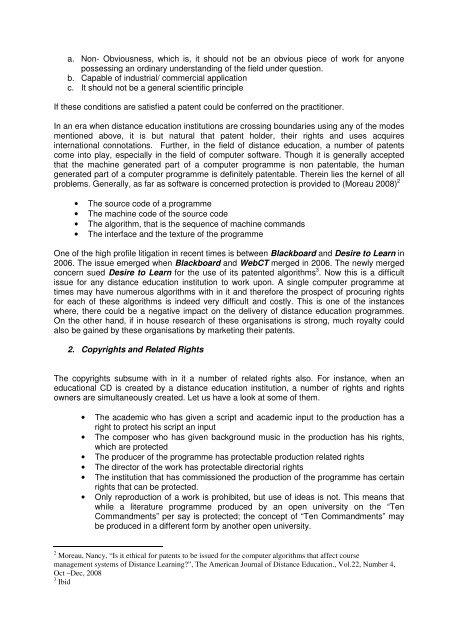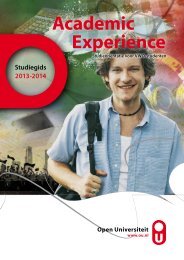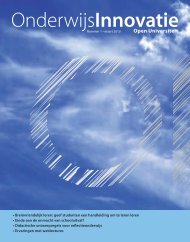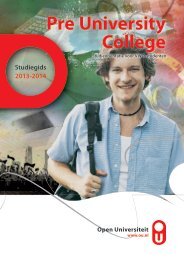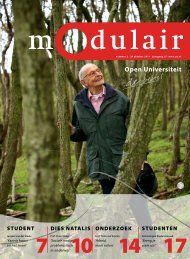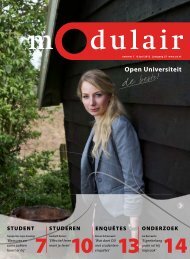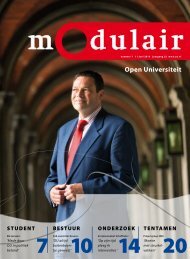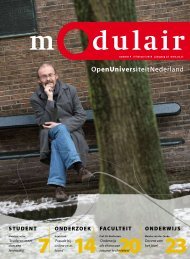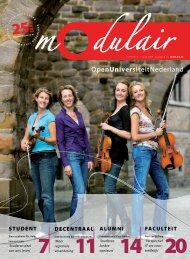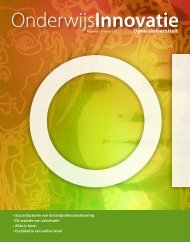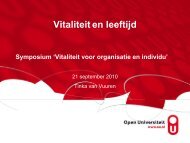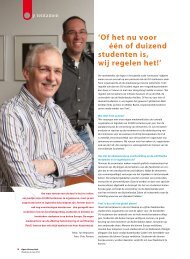intellectual property rights and distance education institutions
intellectual property rights and distance education institutions
intellectual property rights and distance education institutions
You also want an ePaper? Increase the reach of your titles
YUMPU automatically turns print PDFs into web optimized ePapers that Google loves.
a. Non- Obviousness, which is, it should not be an obvious piece of work for anyone<br />
possessing an ordinary underst<strong>and</strong>ing of the field under question.<br />
b. Capable of industrial/ commercial application<br />
c. It should not be a general scientific principle<br />
If these conditions are satisfied a patent could be conferred on the practitioner.<br />
In an era when <strong>distance</strong> <strong>education</strong> <strong>institutions</strong> are crossing boundaries using any of the modes<br />
mentioned above, it is but natural that patent holder, their <strong>rights</strong> <strong>and</strong> uses acquires<br />
international connotations. Further, in the field of <strong>distance</strong> <strong>education</strong>, a number of patents<br />
come into play, especially in the field of computer software. Though it is generally accepted<br />
that the machine generated part of a computer programme is non patentable, the human<br />
generated part of a computer programme is definitely patentable. Therein lies the kernel of all<br />
problems. Generally, as far as software is concerned protection is provided to (Moreau 2008) 2<br />
• The source code of a programme<br />
• The machine code of the source code<br />
• The algorithm, that is the sequence of machine comm<strong>and</strong>s<br />
• The interface <strong>and</strong> the texture of the programme<br />
One of the high profile litigation in recent times is between Blackboard <strong>and</strong> Desire to Learn in<br />
2006. The issue emerged when Blackboard <strong>and</strong> WebCT merged in 2006. The newly merged<br />
concern sued Desire to Learn for the use of its patented algorithms 3 . Now this is a difficult<br />
issue for any <strong>distance</strong> <strong>education</strong> institution to work upon. A single computer programme at<br />
times may have numerous algorithms with in it <strong>and</strong> therefore the prospect of procuring <strong>rights</strong><br />
for each of these algorithms is indeed very difficult <strong>and</strong> costly. This is one of the instances<br />
where, there could be a negative impact on the delivery of <strong>distance</strong> <strong>education</strong> programmes.<br />
On the other h<strong>and</strong>, if in house research of these organisations is strong, much royalty could<br />
also be gained by these organisations by marketing their patents.<br />
2. Copy<strong>rights</strong> <strong>and</strong> Related Rights<br />
The copy<strong>rights</strong> subsume with in it a number of related <strong>rights</strong> also. For instance, when an<br />
<strong>education</strong>al CD is created by a <strong>distance</strong> <strong>education</strong> institution, a number of <strong>rights</strong> <strong>and</strong> <strong>rights</strong><br />
owners are simultaneously created. Let us have a look at some of them.<br />
• The academic who has given a script <strong>and</strong> academic input to the production has a<br />
right to protect his script an input<br />
• The composer who has given background music in the production has his <strong>rights</strong>,<br />
which are protected<br />
• The producer of the programme has protectable production related <strong>rights</strong><br />
• The director of the work has protectable directorial <strong>rights</strong><br />
• The institution that has commissioned the production of the programme has certain<br />
<strong>rights</strong> that can be protected.<br />
• Only reproduction of a work is prohibited, but use of ideas is not. This means that<br />
while a literature programme produced by an open university on the “Ten<br />
Comm<strong>and</strong>ments” per say is protected; the concept of “Ten Comm<strong>and</strong>ments” may<br />
be produced in a different form by another open university.<br />
2 Moreau, Nancy, “Is it ethical for patents to be issued for the computer algorithms that affect course<br />
management systems of Distance Learning?”, The American Journal of Distance Education., Vol.22, Number 4,<br />
Oct –Dec, 2008<br />
3 Ibid


